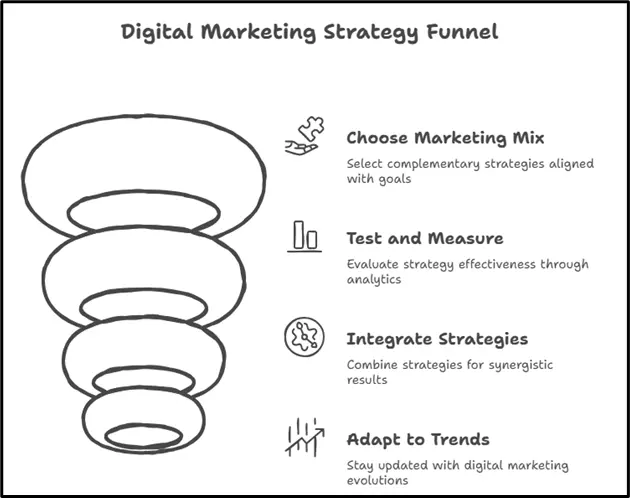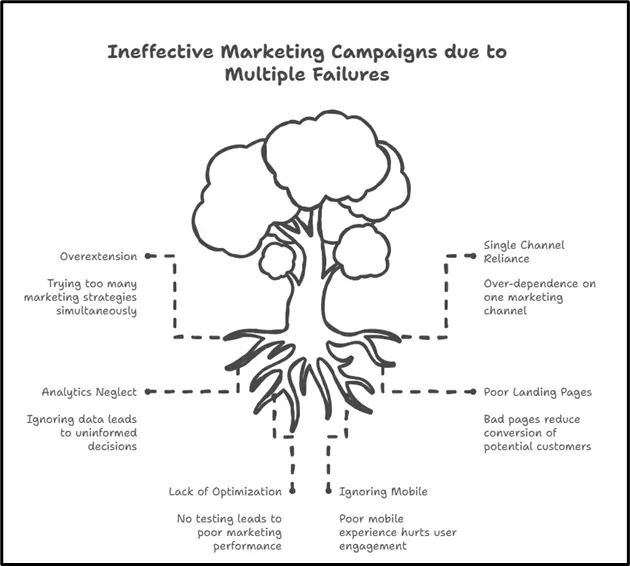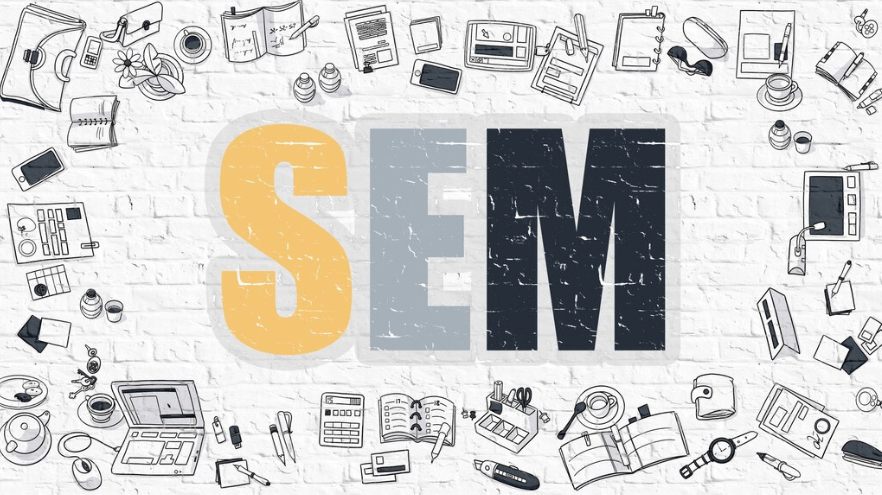If you’re a marketer on the lookout for the right digital marketing strategy among the many types of digital marketing strategies, then this blog is for you.
It always helps to dig into the basics before making bi decisions. Here, we have discussed them all with how they work, when to use them, their pros and cons, and tips to make them effective.
By the end, you should have a clearer map of where to focus your effort (and budget), depending on your goals.
In this blog, we’ll cover:
- What is Digital Marketing?
- 14 Core Types of Digital Marketing
- How to Choose & Combine Types of Digital Marketing Strategies
- Common Mistakes & Pitfalls to Avoid
- Future Trends & What’s Next
What is Digital Marketing?
Digital marketing means using digital channels, platforms, tools, and strategies to tell people about products or services, connect with audiences, build brands, and drive action (sales, leads, awareness, etc.).
This includes everything from showing ads on search engines to engaging people over social media, sending emails, optimizing for search engines, using influencers, and more.
One big advantage of digital marketing (versus traditional media) is measurability and flexibility. You can see what’s working (and what’s not) in real time, tweak accordingly, and scale up or down quickly.
Now, when someone says “types of digital marketing strategies,” they generally refer to different approaches or channels you can use.
Core Types of Digital Marketing Strategies
To create a strategy that you can swear by, you should know your options. Let’s explore them one by one:
1. Search Engine Optimization (SEO)
What is it?
SEO is optimizing your website(and now your social media accounts) and its content to ensure search engines (like Google) rank you on the top in organic (non-ad) results when people search for relevant queries.
Why it matters:
Around 32.9% of internet users aged 16+ find out about new brands, products, and services through search engines. When your potential customers type something into Google, you want your content to appear among the top results. High ranking means more traffic, credibility, and leads — without paying for every click.
Key sub-areas:
- On-page SEO: optimizing page content, meta tags, headings, images, keyword usage, internal linking.
- Technical SEO: site speed, mobile friendliness, site architecture, schema, crawlability.
- Off-page SEO / Link Building: obtaining backlinks from trusted sites, mentions, brand authority.
- Local SEO: for local businesses, optimizing for “near me” searches, Google Business Profile, maps.
- E-commerce SEO: optimizing product pages, schema for products, category pages, reviews.
Pros:
- Long-term & compounding benefits
- Cost-effective (you don’t pay for every click)
- Builds authority & trust
- Drives consistent organic traffic
Challenges / Cons:
- Takes time (months to see strong results)
- Competitive (many niches have fierce SEO competition)
- Requires ongoing maintenance (algorithm updates, content freshening)
Tips:
- Start with good keyword research (what people are actually searching)
- Create high-quality, helpful content (not just SEO “tricks”)
- Monitor technical issues (site speed, mobile, broken links)
- Earn real, relevant backlinks
- Use SEO + content + UX together. SEO isn’t a standalone “hack”
2. Content Marketing
What is it?
Content marketing involves crafting and distributing valuable, relevant content (blogs, guides, videos, infographics, podcasts, etc.) to attract, engage, and retain your target audience.
How it fits in:
Content is often the backbone: your SEO, social media, and email strategies lean heavily on content. “Content is king,” as they say.
Why it matters:
- Helps you build trust, authority, and relationship with your audience
- Gives you material to share across multiple platforms
- Helps with SEO (fresh content, relevancy, internal linking)
- Over time, your content “asset library” can keep bringing traffic (evergreen content)
Types of content formats:
- Blog posts / articles
- E-books, guides, whitepapers
- Infographics, charts, visuals
- Videos, webinars
- Podcasts / audio content
- Checklists, templates, tools
- Case studies, interviews
Pros:
- Builds long-term value
- Supports virtually every other marketing channel
- Allows storytelling, brand voice, education
Challenges / Cons:
- Requires time, consistency, resources
- Need to constantly come up with fresh ideas
- May take time to gain traction
Tips:
- Map content as per the different stages of the buyer’s journey (awareness, consideration, decision)
- Use content pillars / clusters (hub & spoke model)
- Repurpose content (e.g. turn a blog into video, infographic, social posts)
- Use analytics to see which content resonates and double down
- Focus on “quality over quantity” – Better fewer great pieces than many mediocre ones
3. Pay-Per-Click (PPC) / Search Engine Marketing (SEM)
What is it?
PPC (also called paid search or SEM) is paid advertising. Here you pay each time someone clicks your ad. For example, Google Ads (search ads), Bing Ads, and even ads on social media platforms (when used as search or display ads).
How it works:
You bid on keywords or target specific audience segments, design ad copy / creative, and send users to a landing page. You pay only when someone clicks (hence “pay per click”).
Why it matters:
- You get immediate visibility
- You can target very specifically (keywords, demographics, location)
- It’s scalable, you control your budget
- Complements SEO (you can appear in paid + organic results)
Pros:
- Quick results (fast traffic)
- Highly measurable
- Flexible budget control
- Good for testing (ad copy, offers, landing pages)
Challenges / Cons:
- Can be expensive (especially in competitive niches)
- Needs careful optimization and monitoring
- If landing pages or offer not good, you waste money
- Once you stop paying, results stop
Tips:
- Start with a small budget and test
- Use targeted keywords (long-tail, negative keywords)
- Optimize landing pages to convert (not just send traffic)
- Track metrics: CTR, conversion rate, CPA, ROAS
- Use A/B testing for ad copy, images, targeting
- Use remarketing (see section later) to maximize ROI
4. Social Media Marketing
What is it?
Social Media is a leading format in the different types of digital marketing strategies. Using social media platforms (Facebook, Instagram, LinkedIn, Twitter / X, TikTok, Pinterest, etc.) to build brand presence, engage with audiences, and drive traffic or conversions.
How it works:
You publish content (text, images, video, stories, reels), run paid social ads, host discussions or live sessions, build a community (comments, replies), collaborate with influencers, etc.
Why it matters:
- Nearly everyone spends time on social media
- You can build relationships and brand loyalty
- Good for awareness, engagement, promotions
- Social ads allow precise targeting
Pros:
- Huge reach & audience potential
- Engagement & two-way communication
- Good for brand personality & storytelling
- Paid + organic synergy
Challenges / Cons:
- Algorithm dependence (reach fluctuates)
- Constant content creation demand
- Negative feedback / reputation risk
- ROI can be less immediate
Tips:
- Choose platforms where your audience is (don’t spread thin)
- Post consistently, but mix variety (videos, stories, polls)
- Listen to your audience (comments, DMs)
- Use platform analytics to see what content works
- Leverage user-generated content (UGC)
- Use paid social to amplify key posts
5. Email Marketing
What is it?
Sending emails to a list of subscribers (people who have opted in) to nurture relationships, promote offers, share content, or drive conversions.
Why it matters:
- High ROI (often cited: for $1 spent, many reports show high returns)
- Direct access to your audience’s inbox
- Great for nurturing, repeat business, upsells
Types of email strategies:
- Newsletters / content updates
- Promotional / sales emails
- Welcome sequences / onboarding flows
- Abandoned cart emails (for e-commerce)
- Drip / nurture campaigns
- Re-engagement emails
Pros:
- You own your list (less platform risk)
- Personalized & segmented communication
- Automation possible
- Good for retention & lifecycles
Challenges / Cons:
- Requires building a quality list
- Avoiding spam / deliverability issues
- Content fatigue (if you send too much)
- Need good copy, design, testing
Tips:
- Use double opt-in to ensure quality list
- Segment your lists (by interest, behavior, demographics)
- Personalize (name, dynamic content)
- Use clean / mobile-friendly email design
- A/B test subject lines, send times
- Monitor metrics: open rate, click-through rate, unsubscribe rate
6. Affiliate / Influencer Marketing
What is it?
- Affiliate marketing: You partner with external publishers / affiliates who promote your product for commission (you pay when a sale or lead happens).
- Influencer marketing: You collaborate with influencers (individuals with a strong following) to promote your brand or product.
Why it matters:
- Leverage others’ audiences
- Performance-based (you often pay only when results occur)
- Can bring trusted voices to your brand
Pros:
- Scalability (lots of affiliates / influencers)
- Trust transfer (if influencer is respected)
- Lower upfront risk
Challenges / Cons:
- Finding good affiliates / influencers
- Ensuring brand alignment
- Managing contracts, tracking, fraud
- Commission margins
Tips:
- Vet affiliates / influencers carefully (audience quality, engagement)
- Use tracking & affiliate software
- Offer incentives or tiered commissions
- Provide creative assets, guidelines
- Build long-term relationships, not just one-off campaigns
7. Mobile Marketing
What is it?
Reaching your audience on their mobile devices (smartphones, tablets) via apps, SMS / text messaging, push notifications, mobile web, location-based marketing.
Why it matters:
- Majority of internet usage happens on mobile
- Mobile-specific experiences (apps, push) can engage users differently
- Opportunity for location-based and context-specific targeting
Examples & tactics:
- SMS marketing, MMS
- Push notifications via apps / web
- In-app advertising
- Mobile-optimized websites (or PWA)
- Location-based offers (geo-fencing)
- QR codes, mobile wallets
Pros:
- Reach users in real-time context
- High open / engagement rates (especially SMS)
- Personal / contextual targeting
Challenges / Cons:
- Intrusive if overused
- Deliverability / spam regulations
- Fragmentation (different devices, OS)
Tips:
- Always get explicit opt-in for SMS / push
- Keep messages short, time-sensitive, relevant
- Use segmentation (e.g. by geography, behavior)
- Test frequency carefully
- Ensure mobile UX (web/app) is smooth
8. Video Marketing
What is it?
Using video content (YouTube, TikTok, Instagram Reels, Facebook Live, webinars) to tell stories, teach, entertain, or sell.
Why it matters:
- Video consumption is skyrocketing
- Videos tend to engage and retain attention more than plain text
- Great for product demos, tutorials, stories, behind-the-scenes
Formats & platforms:
- Long-form (YouTube, course, webinars)
- Short-form (Reels, TikTok, Shorts)
- Live video / streaming
- Animated explainer videos
- Video ads (pre-roll, mid-roll)
Pros:
- Strong engagement & emotional connection
- Good for storytelling and demonstrations
- Highly shareable
Challenges / Cons:
- Production cost / skill required
- Need consistency & planning
- Algorithm dependencies
Tips:
- Plan video content calendar
- Use subtitles (many watch without sound)
- Keep intros engaging (hook within first seconds)
- Repurpose video: clip segments, convert to blog, audio
- Use analytics to measure view time, drop-off
9. Online PR / Reputation Management
What is it?
Managing your brand’s online perception, press mentions, guest blogging, media relations, reviews, responding to articles or social feedback.
Why it matters:
- Strong reputation helps trust & credibility
- Good PR boosts exposure, backlinks, brand authority
- Negative reviews or bad press can hurt credibility
Tactics:
- Press releases, media outreach
- Guest posts, contributed articles
- Review management (encouraging good reviews, responding to bad reviews)
- Brand monitoring and sentiment analysis
- Partnerships, brand collaborations
Pros:
- Boosts credibility and authority
- Generates earned media and backlinks
- Can amplify reach beyond your network
Challenges / Cons:
- Hard to control what others say
- Requires proactive effort
- May take time for media to pick up
Tips:
- Build relationships with journalists, bloggers
- Monitor brand mentions (tools like Google Alerts, Mention)
- React genuinely and transparently to negative feedback
- Offer value (expert insights, interesting stories) rather than just promoting
10. Chatbot / Conversational Marketing / Messaging
What is it?
Using chatbots, messaging apps (WhatsApp, Messenger, Telegram), live chat on websites, or conversational AI to engage visitors, answer queries, qualify leads, or provide customer support.
Why it matters:
- Users expect immediate answers
- Conversational interfaces reduce friction
- Can guide a visitor toward conversion
Tactics:
- Website chatbot that asks “How can I help you?”
- Messenger bots or flows (e.g. lead qualification)
- WhatsApp marketing or support
- Conversational landing pages
Pros:
- 24/7 user engagement
- Can pre-qualify leads and route to sales
- Reduces support burden
Challenges / Cons:
- Needs good design / flow (bad chatbot = frustration)
- Users may dislike conversations if overly automated
- Maintenance as FAQs or products change
Tips:
- Start with a clear use case (e.g. lead gen, FAQ, support)
- Use natural language / fallback for unknown queries
- Log conversations and improve flows over time
- Combine bot + human handoff
11. Remarketing / Retargeting
What is it?
Displaying ads to users who’ve already visited your website (or expressed interest) but didn’t take the desired action, essentially “retargeting” them to encourage a return and complete their journey.
Why it matters:
- Many visitors leave without converting, remarketing gives you another chance
- Improves ROI (you’re targeting warmer audience)
How it works:
- Place a pixel / tag on your website
- Capture visitor behavior (pages they saw)
- Show relevant ads later on display networks, social platforms
Pros:
- High conversion potential
- Keeps your brand top of mind
- Custom messaging based on behavior (e.g. “You left book in cart”)
Challenges / Cons:
- Ad fatigue if overused
- Privacy / cookie restrictions
- Frequency capping must be managed
Tips:
- Segment audiences (all visitors, cart abandoners, high-value visitors)
- Use dynamic ads (show exactly what they viewed)
- Set frequency caps so you don’t annoy people
- Use sequential messaging (first ad, then next, then final)
12. Account-Based Marketing (ABM)
What is it?
ABM is more of a B2B approach: you identify high-value target accounts (companies), then tailor marketing efforts specifically for them (versus broad outreach). You treat each account like a market itself.
How it works:
- Collaborate with sales to pick key accounts
- Use personalized content, ads, outreach
- Coordinate multi-channel campaigns (email, LinkedIn, webinars)
Why it matters:
- Higher ROI if accounts are carefully chosen
- Better alignment with sales
- More personalization and higher conversion rates
Pros:
- Efficient use of resources (focusing on high-value)
- Stronger personalization & relationship
- Better ROI in many B2B settings
Challenges / Cons:
- Requires close sales + marketing alignment
- More labor-intensive (custom content)
- May scale less easily
Tips:
- Start small (pilot with few accounts)
- Create custom content / messaging per account
- Use intent data or firmographics to identify targets
- Use coordinated outreach and multi-channel touchpoints
13. Voice / Audio Marketing
What is it?
Leveraging voice-activated devices or audio content like podcasts, smart speakers (Alexa, Google Assistant), audio ads.
Why it matters:
- Voice search is growing (13% of marketers invest in voice search optimization.)
- People listen to podcasts, talk to smart speakers
- Different channel to reach audience
Tactics:
- Podcast advertising / sponsorship
- Creating your own podcast
- Optimizing for voice search (conversational keywords)
- Audio ads (Spotify, podcast ads)
Pros:
- Reaches audiences in “non-screen” contexts (driving, walking)
- Builds intimacy / loyalty (podcast audiences are often very engaged)
Challenges / Cons:
- Harder to measure some audio metrics
- Requires audio production skills
- Voice SEO is still evolving
Tips:
- Think of conversational (question) keywords
- Use transcripts, show notes for discoverability
- Promote your audio content across other channels
- Collaborate with podcasters or audio platforms
14. Emerging / Future Approaches
As technology advances, new types of digital marketing strategies become possible. A few to watch:
- Augmented Reality (AR) / Virtual Reality (VR) marketing – Letting users “try” products virtually
- Immersive / experiential marketing – Enveloping audiences in brand experiences across channels (see immersion marketing)
- Generative AI & AI-driven storytelling – Creating personalized narratives / content dynamically.
- Interactive content / gamification – Quizzes, polls, interactive video
- Conversational commerce / voice commerce
- AI chat agents / recommendation engines
- Metaverse marketing / spatial marketing
These aren’t yet “core” for many businesses but present exciting opportunities as adoption grows.
How to Choose & Combine Types of Digital Marketing Strategies
So many strategies but where do you begin? Here’s a roadmap:

Image 1.1. Digital marketing strategy funnel
1. Start with goals & audience
- What is your primary goal? (brand awareness, leads, sales, retention)
- Who is your audience. Figure out their demographics, behaviors, platforms they use
- What is your budget and internal capacity (content creation, ads, tech)
2. Pick a mix (a “marketing stack”)
Don’t try to do it all at once. Focus on a few complementary types that match your goals and resources.
For example:
- A content + SEO + email core (long-term foundation)
- Add PPC + remarketing to accelerate results
- Use social media and influencers for reach and trust
- Use chatbots or messaging for lead qualification / support
3. Test, measure, iterate
- Use analytics and metrics (traffic, conversions, ROI)
- Run small tests before scaling
- Drop or pivot what doesn’t work; double down on what does
4. Integrate strategies (synergy > silos)
One powerful thing: these strategies support each other.
- Content powers SEO, social, email
- Email nurtures leads from content or social
- PPC can promote your best content or offers
- Remarketing complements PPC & social
- Influencers can drive content, awareness, and backlinks
So think of your digital marketing not as isolated silos but an ecosystem.
5. Be adaptive & keep up with trends
Digital marketing evolves fast: algorithms change, new channels emerge, user behavior shifts. Stay curious, learn, experiment.
Common Mistakes & Pitfalls to Avoid

- Spreading yourself too thin, trying all strategies at once
- Over-relying on one channel (e.g. only paid ads)
- Ignoring analytics or not setting up proper tracking
- Poor landing pages (driving traffic but not converting)
- Not testing / optimizing (ad creatives, copy, segmentation)
- Ignoring mobile experience
- Focusing only on acquisition; neglecting retention
- Being too promotional; not giving value in content
- Bad influencer partnerships (misaligned values, fake followers)
Future Trends & What’s Next
As we look ahead, here are a few trends and shifts to keep an eye on in the realm of digital marketing:
- AI-powered marketing & content generation – Using tools to help create content, ads, emails, personalization
- Hyper-personalization – Customizing user experience in real-time based on behavior, context
- Privacy & data changes – Browser cookie deprecation, stricter privacy laws (GDPR, CCPA, etc.)
- Voice / conversational marketing growth
- More interactive / immersive experiences (AR/VR, gamified content)
- Video-first / short-form content dominance
- Omni-channel user journeys – Fluid transitions between web, mobile, offline, in-app
To stay competitive, marketers will need to be agile and experiment continuously.
Summary & Final Thoughts
Digital marketing is not a one-size-fits-all game. There are varied types of digital marketing strategies, each with its strengths, challenges, and ideal use cases. The magic often lies in combining strategies smartly, testing what works for your audience, and scaling based on data.
If you’re looking for digital marketing services, you can always count on Wildnet Technologies.
For help creating and executing any of these digital-marketing strategies—whether it’s SEO, content, social media, or multi-channel campaigns—consider partnering with Wildnet Technologies. Their team can tailor the right mix of tactics to your business needs and help you drive measurable growth.
FAQs
Question 1. What is a buyer’s journey in digital marketing?
Answer. In digital marketing, a buyer’s journey is the simple path a person follows before buying something. They first realize a need (awareness), then look for options (consideration), and finally choose and buy (decision).
Question 2. What’s the difference between “on-page SEO” and “off-page SEO”?
Answer. On-page SEO = optimizing things on your site (content, tags, structure). Off-page SEO = building links, reputation outside your site.
Question 3. What is a “landing page” and why is it important in PPC campaigns?
Answer. A landing page is basically a page where users arrive after clicking your ad. It’s crucial for converting that click into action (sale, signup).
Question 4. What does “frequency cap” mean in remarketing / retargeting?
Answer. It limits how many times a user sees your ad, so you don’t annoy them by overexposure.
Question 5. What’s the difference between a chatbot and live chat?
Answer. A chatbot is automated (rules or AI) and handles common queries. Live chat is handled by a human agent in real time.







